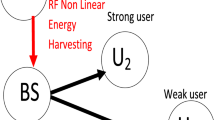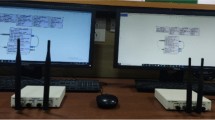Abstract
In this paper, spectrum sensing for primary user (PU) is considered in additive Laplacian noise. Further, we consider dynamic behaviour of PU, where the transitions of PU in both the null and the alternate hypotheses have been modelled by two state discrete time Markov chain (DTMC). We assume PU signal to be quadrature amplitude modulated (M-QAM) with ‘M’ modulation order. The considered Markov parameters are \(\tau _o\) and \(\mu _o\), which represent the average number of samples present during active (ON) state and idle (OFF) state of the PU, respectively. Furthermore, the \(\tau _o\) and \(\mu _o\) are functions of transition probability matrix (TPM) in DTMC. At the cognitive terminal for spectrum sensing, we assume perfect information of the TPM or in other words \(\tau _o\) and \(\mu _o\). Then, we use prevailing detection schemes such as improved absolute value cumulation detection (i-AVCD) with the TPM. We refer to this scheme as modified i-AVCD and derive the resulting detection variable along with threshold. In the detection variable, the received samples at the cognitive terminal are raised to a positive exponent P with range of P defined as \(0<P\le 2\). We also derive analytical expressions of the detection probability \((P_D)\) and false alarm probability \((P_F)\). We present our results with receiver operating characteristics (ROC) for the considered scheme. We also present simulation results and find close matching with the analytical counterparts. We discuss the effect of increasing modulation order M on the detection performance. We also discuss a special case of M-QAM at \(M=2\) which refers to binary phase shift keying (BPSK) modulation scheme for PU. Further, we discuss special cases of the considered scheme at \(P=1\) and \(P=2\), i.e., modified AVCD and modified energy detection, respectively. Finally, we compare the performance of the considered scheme with the conventional i-AVCD detection scheme, where information of DTMC or in other words TPM, is not available at the cognitive terminal. We find that the considered scheme outperforms the conventional scheme.





Similar content being viewed by others
References
Oughton, E. J., & Jha, A. (2021). Supportive 5G infrastructure policies are essential for universal 6G: Assessment using an open-source techno-economic simulation model utilizing remote sensing. IEEE Access, 9, 101924–101945.
Agiwal, M., Roy, A., & Saxena, N. (2016). Next generation 5G wireless networks: A comprehensive survey. EEE Communications Surveys and Tutorials, 18(3), 1617–1655.
Liu, C., & Tsai, H. (2017). Traffic management for heterogeneous networks with opportunistic unlicensed spectrum sharing. IEEE Transactions on Wireless Communications, 16(9), 5717–5731.
Hu, F., Chen, B., & Zhu, K. (2018). Full spectrum sharing in cognitive radio networks toward 5G: A survey. IEEE Access, 6, 15754–15776.
Kumar, A., Thakur, P., Pandit, S., et al. (2019). Analysis of optimal threshold selection for spectrum sensing in a cognitive radio network: an energy detection approach. Wireless Networks, 25, 3917–3931.
Chen, Y. (2010). Improved energy detector for random signals in Gaussian noise. IEEE Transactions on Wireless Communications, 9(2), 558–563.
Beaulieu, N. C., & Chen, Y. (2010). Improved energy detectors for cognitive radios with randomly arriving or departing primary users. IEEE Signal Processing Letters, 17(10), 867–870.
miri-Doomari, S., Mirjalily, G., & Abouei, J. (2019). Stability-based routing, link scheduling and channel assignment in cognitive radio mobile ad-hoc networks. Wireless Networks, 25, 2013–2026.
MacDonald, S., Popescu, D. C., & Popescu, O. (2017). Analyzing the performance of spectrum sensing in cognitive radio systems with dynamic PU activity. IEEE Communications Letters, 21(9), 2037–2040.
Wang, Y., Xu, Y., Shen, L., & Cheng, Y. (2014). Two-dimensional POMDP-based opportunistic spectrum access in time-varying environment with fading channels. Journal of Communications and Networks, 16(2), 217–226.
Hossain, M., & Xie, J. (2020). Hide and seek: A Markov-based defense strategy against off-sensing attack in cognitive radio networks. IEEE Transactions on Network Science and Engineering, 7(4), 3028–3041.
Sun, Y., Mark, B. L., & Ephraim, y. (2016). Collaborative spectrum sensing via online estimation of hidden bBivariate Markov models. IIEEE Transactions on Wireless Communications, 15(8), 5430–5439.
Wang, Z., Liu, L., & Li, K. (2020). Dynamic Markov chain Monte Carlo-based spectrum sensing. IEEE Signal Processing Letters, 27, 1380–1384.
Shongwe, T., Vinck, A. J. H., & Ferreira, H. C. (2015). A study on impulse noise and its models. SAIEE Africa Research Journal, 106(3), 119–131.
Hu, B., & Beaulieu, N. C. (2008). On characterizing multiple access interference in TH-UWB systems with impulsive noise models. in 2008 IEEE Radio and Wireless Symposium (pp. 879-882).
Win, M. Z., & Scholtz, R. A. (2000). Ultra-wide bandwidth time-hopping spread-spectrum impulse radio for wireless multiple-access communications. IEEE Transactions on Communications, 48(4), 679–689.
Ye, Y., Li, Y., Lu, G., & Zhou, F. (2000). Improved energy detection with Laplacian noise in cognitive radio. IEEE Systems Journal, 13(1), 18–29.
Wimalajeewa, T., & Varshney, P. K. (2011). Polarity-coincidence-array based spectrum sensing for multiple antenna cognitive radios in the presence of non-Gaussian noise. IEEE Transactions on Wireless Communications, 10(7), 2362–2371.
Kay, S. M. (1998). Fundamentals of statistical signal processing, Volume II: Detection theory. Prentice-Hall.
MacDonald, S., Popescu, D. C., & Popescu, O. (2017). Analyzing the performance of spectrum sensing in cognitive radio systems with dynamic PU activity. IEEE Communications Letters, 21(91), 2037–2040.
Shao, M., & Nikias, C. L. (1993). Signal processing with fractional lower order moments: Stable processes and their applications. Proceedings of the IEEE, 81(7), 986–1010.
Okyere, B., Musavian, L., & Mumtaz, R. (2021). Performance analysis of physical layer network coding in massive MIMO systems with M-QAM modulations. EEE Transactions on Vehicular Technoloy, 70(5), 4631–4645.
Sinha, K., & Trivedi, Y. N. (2021). Spectrum sensing techniques based on last status change point estimation for dynamic primary user in additive Laplacian noise. Wireless Personal Communications, 122, 2131–2143.
Geddes, K. O., Glasser, M. L., Moore, R. A., et al. (1990). Evaluation of classes of definite integrals involving elementary functions via differentiation of special functions. Algebra in Engineering, Communication and Computing, 1(2), 149–165.
Author information
Authors and Affiliations
Corresponding author
Ethics declarations
Conflict of Interest
On behalf of all authors, the corresponding author states that there is no conflict of interest.
Additional information
Publisher's Note
Springer Nature remains neutral with regard to jurisdictional claims in published maps and institutional affiliations.
Appendices
Appendix A Derivation of \(E[Z(\mathbf{y} )\vert H_o]\)
Hence,
Now, solving \(\beta _1\) and \(\beta _2\), we get
where \(w_1, w_2,\cdots ,w_{N_{00}}\) are assumed to be independent and identically distributed (i.i.d). Hence, \(E[w_1]=E[w_2]=\cdots =E[w_{N_{00}}]=\psi _o\). Hence,
Similarly,
Appendix B Derivation of \(var[Z(\mathbf{y} )\vert H_o]\)
Hence,
Now, solving \(\xi _o\) and \(\xi _1\), we get
where \(w_1, w_2,\cdots ,w_{N_{10}}\) are assumed to be independent and identically distributed (i.i.d). Hence, \(var[w_1]=var[w_2]=\cdots =var[w_{N_{10}}]=\sigma _o^2\). Hence,
Similarly,
Rights and permissions
About this article
Cite this article
Sinha, K., Trivedi, Y.N. Spectrum sensing based on two state discrete time Markov chain in additive Laplacian noise. Wireless Netw 28, 2393–2402 (2022). https://doi.org/10.1007/s11276-022-02979-x
Accepted:
Published:
Issue Date:
DOI: https://doi.org/10.1007/s11276-022-02979-x




